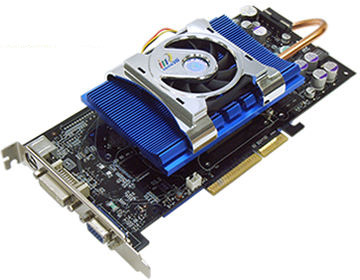Page 2
Introducing the GeForce 6800Let's talk a little about the generic GeForce 6800 features. The graphics core itself is build upon a 0.13 Micron Process technology that is fabricated at IBM. As rumors suggested the 6800 indeed has a lot of transistors. I personally didn't count them but NVIDIA states that there are 222 Million transistors, now imagine all that on a 40mm x 40mm FlipChip GPU running ~350 MHz. What you heard is true, the transistor count of this actual core is higher than a Pentium 4 Extreme Edition has. Since we are on the topic of the core, there are 6 vertex units inside it, and as recently discovered any model that is not ultra has at least 1 Vertex processor disabled. One of the biggest advantages of the Series 6 is of course the increased number of pixel pipelines. The more the faster, is the general consensus, 16 is best right now. This model has 12.
Let me explain briefly what happens in the pipeline for you to understand its importance, each pixel that is rendered on your screen goes through a pipe where it'll receive its complex color/effect etc. Each time that pixel is altered it'll pass through the pixel pipeline, one pass is one clock cycle. You can imagine going from 8 towards 12 or 16 pipes can bring you a dramatic performance increase. I have to note here that these are not theoretical pipelines as rumored by some websites prior to the product announcements. They are scalable though, each pipe is available at any time in sets of 4. Where NV35 was stereotyped as 4x2/8x0 architecture, the NV40 is 16x1/32x0 or in the case of the standard 6800 1x12.
The silicon itself is of course PCI-Express ready as we've recently tested yet the one we are talking about today is running steady on AGP 8x. PCI-Express has double the bandwidth of AGP8x and another plus; it allows data to be sent in both directions. However performance-wise, right now there hardly a difference.
Board Design
The 6800 Ultra is equipped with the latest available in affordable, yet really fast, DDR memory. On the 6800 Ultra it is running at 1.2 GHz (2x600 MHz), the GT is running at 1 GHz (2x500 MHz) and the standard 6800 has a core of 325 MHz and 700 MHz (2x350 MHz) memory frequency.
Taking a closer look at the board, we can tell that InnoVision/Inno3D used the standard reference design P212 PCB. So don't expect miracles in tweaking thanks to board design. Next to that our sample was equipped with the reference cooler from NVIDIA. Recently Inno3D made a nice deal with CoolerMaster though and in the near future we are going to observe some very interesting products cooling wise. Inno3D will be releasing a "Premium Edition" of the card we are testing today, a heatpipe cooled GeForce 6800 with a tiny fan, which looks fantastic.

The PCB is, as stated, P212 and has my preferred PCB color: black. No flashy LED's or anything, just the card in its most basic form. The memory onboard was DDR1 rated at 2.5ns, which should guarantee us at least a memory frequency of 800 MHz. We'll check that part out during overclocking though.
To tidy things up a bit I've made a little overview
- 12 pipeline GPU architecture (16 on 6800 GT & Ultra).
- Up-to 8x more shading performance compared to the previous generation
- CineFX 3.0 engine - Yes indeed... DirectX Shaders model 3.0 for really nice visual effects
- On Chip Video processor.
- DDR1 memory on a 256-bit Memory interface @ 700 MHz
- UltraShadow II technology - Very well then...3x to 4x faster than NV35
- High Precision Dynamic Range (HPDR) technology - we'll discuss this later in the article
- 128-studio precision through the entire pipeline - 32-bit Color precision; this time with nice performance.
- IntelliSample 3.0 Technology - 16x Anisotropic Filtering & Rotating Grid Anti Aliasing
- Full MPEG encoding and decoding at GPU level !
- Advanced Adaptive De-Interlacing
- Video Scaling and Filtering - HQ filtering techniques including HDTV resolutions
- Integrated TV Encoder - TV-output up-to 1028x768 resolutions
- OpenGL 1.5 Optimizations and support
- DVC 3.0 (Digital Vibrance Control)
- Dual 400 MHz RAMDACs which support QXGA displays up-to 2048x1536 @ 85 Hz
- Dual DVI
| Specs | GeForce 6600 | GeForce 6600 GT | GeForce 6800 | GeForce 6800 GT | GeForce 6800 Ultra |
| Codename | NV43 | NV43 | NV40 | NV40GT | NV40U |
| Transistors | 222 million | 222 million | 222 million | ||
| Process, GPU maker | 110nm | 110nm | 130nm, IBM | ||
| Core clock | 300 MHz | 500 MHz | Up to 400 MHz | 350MHz | 400-450 MHz |
| Memory | 128MB DDR1 | 128MB GDDR3 | 128MB DDR1 | 256MB GDDR3 | 256MB GDDR3 |
| Memory bus | 128-bit | 256-bit | |||
| Memory clock | Up to manufacturer | 2x500 MHz | 2 x 550MHz | 2 x 500MHz | 2 x 600MHz |
| PCB | P212 | P212 | P2?? | P210 | P210 |
| Pipelines | 8 | 8 | 12 | 16 | 16 |
| FP operations | FP16, FP32 | ||||
| DirectX | DirectX 9.0c | ||||
| Pixel shaders | PS 3.0 | ||||
| Vertex shaders | VS 3.0 | ||||
| OpenGL | 1.5+ (2.0) | ||||
| Price | $150 | $229 | $299 | $399 | $499 |
| Availability | Sep/Oct 2004 | Sep/Oct 2004 | May/June 2004 | ||
